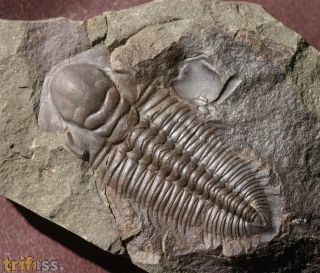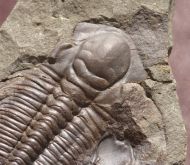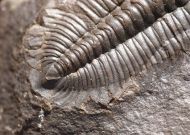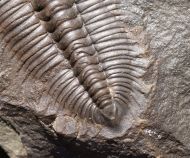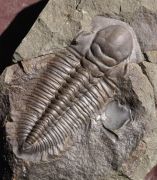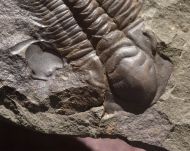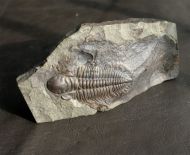Here is a rare Rejkocephalus rotundatus from the Cambrian Jince fm.
This trilobite offers a good preservation and shows well in the nice matrix.
The Trilobite genus Rejkocephalus has on all 3 species 17 thoraxal segements.
For example Hydrocephalus has 18 body segments on the species Hydrocephalus carens and Hydrocephalus minor, Hydrocephalus mandiki does have 19 pleural segments.
Rejkocephalus differs also on the cephalon from Hydrocephalus. The Glabellar furrow S1 and S2 are mush more prominent. On Hydrocephalus those are barely visible. On the Occipital lobe of Rejkocephalus does show a short spine. But this is mostly only visible on the external moult. The Palpebral lobe is on Hydrocephalus larger than on Rejkocephalus.
If Rejkocephalus and Hydrocephalus are compared in same size servile other differences are observable. The genal spines of Rejkocephalus are mush longer than on Hydrocephalus. On Hydrocephalus these are more narrow to the thorax. On Rejkocephalus they are more widely corved, on the ends pointing back to the Thorax. On specimens till about 6 cm in length are the genal spines are longer then the thorax and pygidium. Rejkocephalus rotundatus has in tendency slightly shorter genal spines compared to other Rejkocephalus species but still way longer than on Hydrocephalus.
The Pygidium of the genus Hydrocephalus is elliptic shaped, the pygidial axis is transvveral. The Pygidium of the genus Rejkocephalus is round to hart shape, the longer pygidial axis is sagital.
Rejkocephalus and Hydrocephalus are compared in same size would show a mush differently sized pygidium. The tail of Rejkocephalus is about 80% larger than on Hydrocephalus. On Rejkocephalus runs the pygidial rim out in a pair of narrow spines that pointing a degree of about 20° up. This spines mostly break off and are missing, but the forking structure is well visible in dublicature. This spines have a lenth of about 15-20 % of the pygidium on R. rotundatus or up to nearly 60 % on Rejkocephalus knizeki.
Rejkocephalus and Hydrocephalus have a difernt body shape due there different shapled pleural segments. The Pleural spines of of Rejkocephalus is longer than that on Hydrocephalus. The three last pleural segments differ clearly. On Hydrocephalus shows the 3rd segment (pleural segment 15) before the pygidum the longest pleural spine of the last three body segments. It is pointing sagital to the back and ends after the pygidium. The last plaural segments of Hydrocephalus is the shortest one and is ached, so that it surrounds the pygidium. Its ends dont point backward, the tips are orientated sagital to the pygidial axis.
On Rejkocephalus is the last of the last three pleural segemetns the longest one. The Pleuralspines are nor curved and pointing backwards.
It is suspected that Rejkocephalus lived in more shallow water, in a more dynamic environment. Rejkocephalus was more likely a better swimmer compared to Hydrocephalus. |
